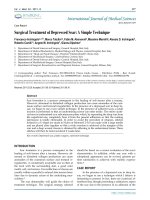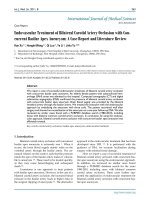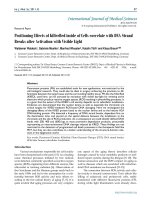Báo cáo y học: "Anticancer Activity of the PR Domain of Tumor Suppressor RIZ1"
Bạn đang xem bản rút gọn của tài liệu. Xem và tải ngay bản đầy đủ của tài liệu tại đây (685.68 KB, 7 trang )
Int. J. Med. Sci. 2011, 8
161
I
I
n
n
t
t
e
e
r
r
n
n
a
a
t
t
i
i
o
o
n
n
a
a
l
l
J
J
o
o
u
u
r
r
n
n
a
a
l
l
o
o
f
f
M
M
e
e
d
d
i
i
c
c
a
a
l
l
S
S
c
c
i
i
e
e
n
n
c
c
e
e
s
s
2011; 8(2):161-167
© Ivyspring International Publisher. All rights reserved.
Short Research Communication
Anticancer Activity of the PR Domain of Tumor Suppressor RIZ1
Wanpeng Sun
1
, Ling Qiao
2
, Qiang Liu
2
, Lifeng Chen
1
, Binbing Ling
1
, Ramaswami Sammynaiken
3
and Jian
Yang
1,
1. Drug Design and Discovery Research Group, College of Pharmacy and Nutrition, University of Saskatchewan, 110
Science Place, Saskatoon, SK S7N 5C9, Canada
2. Vaccine and Infectious Disease Organization, University of Saskatchewan, 120 Veterinary Road, Saskatoon, SK S7N 5E3,
Canada
3. Saskatchewan Structural Sciences Centre, University of Saskatchewan, 110 Science Place, Saskatoon, SK S7N 5C9, Canada
Corresponding author: Jian Yang, Drug Design and Discovery Research Group, College of Pharmacy and Nutrition,
University of Saskatchewan, 110 Science Place, Saskatoon, SK S7N 5C9, Canada. Tel: 306-966-6361; Fax: 306-966-6377; E-mail:
Received: 2010.09.03; Accepted: 2011.02.15; Published: 2011.02.21
Abstract
Human tumor suppressor gene RIZ encodes two protein products, tumor suppressor RIZ1
and proto-oncoprotein RIZ2, which regulate cellular functions in a Yin-Yang fashion. The only
structural difference between them is that RIZ2 lacks the N-terminal PR domain. In this study,
we showed that RIZ1 mRNA expression level was elevated in stage IV of eight different types
of cancer (stage III for prostate cancer), indicating that RIZ1 might play an important role in
tumor metastasis, and the PR domain alone possessed anticancer activity.
Key words: RIZ1, RIZ, Human tumor suppressor, tumor metastasis
Introduction
Yin-Yang regulation, which refers to dual com-
plimentary opposite reactions, has been discovered in
many biological and physiological regulations. Re-
cently, human tumor suppressor gene RIZ was shown
to function in a Yin-Yang fashion [1, 2]. RIZ, located
on the distal short arm of chromosome 1 (1p36), en-
codes two different protein products, RIZ1 and RIZ2,
using alternative promoters [1-10]. The expression
levels for RIZ1 and RIZ2 are nearly the same among
many different human tissues except for the testes [9].
RIZ2, a proto-oncoprotein, promotes cell division;
whereas RIZ1, a tumor suppressor, arrests cells in the
G2/M phase of the cell cycle and induces apoptosis
[10-12]. An imbalance in the amount of RIZ1 and
RIZ2 may be an important cause of cancer develop-
ment [1]. In fact, silencing of RIZ1 expression, asso-
ciated with increased RIZ2 expression, has been ob-
served in various human cancers, such as hepatoma,
leukemia, malignant lymphoma, breast cancer, colo-
rectal cancer, and thyroid carcinoma [1, 4-8, 13, 14].
RIZ1 and RIZ2 share identical amino acid se-
quences except that RIZ2 lacks the N-terminal PR
domain (PRDM2, ~200 amino acids) [9], which is a
member of the PRDM (PRDI-BF1 and RIZ homology
domain) family [15]. Thus, the PR domain is possibly
responsible for the tumor suppressing activity of
RIZ1. In vitro studies showed that PR interacted with
a PRB (PR-binding) motif located in the C-terminal
region of both RIZ1 and RIZ2, implicating the
Yin-Yang fashion between RIZ1 and RIZ2 in cell reg-
ulations [6, 16, 17]. Seventeen types of PRDMs have
been identified in humans [15, 18]. Most of them are
located near the N-terminal portion of the proteins
followed by zinc-fingers, and are involved in the reg-
ulation of cell division and differentiation [15, 18].
PRDM1, PRDM2, PRDM3, PRDM4, PRDM5, PRDM14
and PRDM16, which have been identified to be re-
lated to cancer, are also functional in a Yin-Yang
fashion [2, 15, 18]. In addition, the PR domain was
shown to possess H3K9 histone methyltransferase
Int. J. Med. Sci. 2011, 8
162
activity [19]. Since histone methylation has been
proposed as an important epigenetic mechanism to
suppress cancer, the histone methyltransferase activ-
ity of the PR domain may as well play a critical role
for the tumor suppressing function of RIZ1 [15].
Despite recent rapid progress in RIZ1 studies,
two important questions have not yet been addressed.
The first question is whether the expression level for
RIZ1 varies over the progression of cancer; and the
second question is whether the PR domain alone
possesses anticancer activity. In this study, we quan-
titatively analyzed the mRNA expression level of
RIZ1 over the disease progression in eight different
types of cancer, and evaluated the anticancer activity
of the PR domain against human hepatoma HuH7
cells through both direct administration of recombi-
nant His
6
-tagged PR and cDNA transfection. Our
results showed that the PR domain alone exhibited
anticancer activity.
Materials and Methods
Overexpression and purification of PR domain
The cloning, overexpression and purification of
recombinant His
6
-tagget PR domain has been pub-
lished previously [20].
Quantitative analysis of the RIZ1 mRNA expres-
sion level
The protocol used to analyze mRNA expression
levels of selected target genes using Origene qPCR
Cancer Survey Panels (Rockville, Maryland, USA) has
been reported previously [21]. Briefly, the primers
and the TaqMan probe for gene RIZ encoding RIZ1
were designed and synthesized by Applied Biosys-
tems (Carlsbad, California, USA) based on the inter-
nally transcribed spacer (ITS) region. The TaqMan
probe was labeled with FAM at 5’-end and
non-fluorescent quencher at 3’-end. The RIZ1 mRNA
expression levels were measured against the Origene
TissueScan Cancer Survey Panel 96-I (twelve patients
for each of the eight selected types of cancer) using
quantitative RT-PCR on an Applied Biosystems 7300
Real-Time PCR System. The RIZ1 mRNA expression
was averaged in each disease stage and normalized to
an internal control, -actin. The fold-difference in
mRNA expression at each disease stage was deter-
mined by comparison to expression levels in normal
patients (stage 0, expression level set as 1). Unpaired
t-test with Welch’s correction between the RIZ1
mRNA expression levels in normal and cancer pa-
tients for each cancer type was performed with
GraphPad Prism 4.0 (GraphPad Software, San Diego,
California, USA).
Cell culture of HuH7 cell line
Human hepatoma HuH7 were cultured in 6-well
cell culture plates in Dulbecco’s Modified Eagle’s
Medium with 10% fetal bovine serum and 1% gen-
tamicin in a humidified, 5% CO
2
atmosphere at 37°C.
The cell cultural media were changed every 2-3 days.
The HuH7 cells were subcultured using 0.25%
trypsin, 0.53 mM EDTA solution before reaching
100% confluence.
Anticancer activity of PR domain by direct ad-
ministration
All cell line experiments were undertaken in
triplicate. The purified recombinant His
6
-tagged PR
domain (> 90% purity) was directly administered into
the cell cultural media with final concentrations of 1
g/mL, 2 g/mL, and 3 g/mL, respectively, after
the HuH7 cells reached 80-90% confluence. Tris-HCl
buffer was used as the blank control. The cells were
treated for 24 hr before the cell death rate was exam-
ined by the trypan blue method. The cells were
stained by 0.01% trypan blue for 10 min and then
examined under a microscope. At least 100 cells were
counted for each treatment. Statistical analysis was
performed using GraphPad InStat (GraphPad Soft-
ware, San Diego, California, USA).
Anticancer activity of PR domain by cDNA
transfection
The cloning of the PR domain (residues 13-193)
has been reported previously [20]. Plasmid DNA
harvested from positively transformed Escherichia coli
DH5 cells was digested by restriction endonucleases
BamHI and XhoI. The digested DNA fragment was
subsequently sub-cloned into the expression vector
pcDNA/HisMax C (Invitrogen, Burlington, Ontario,
Canada) at the BamHI and XhoI sites. The constructed
plasmid pcDNA/HisMax/PR vector was transfected
into HuH7 cells (~ 1 million) by the calcium phos-
phate precipitation method [22]. Transfection with
the empty pcDNA/HisMax C vector was used as a
control. The expression of the PR domain in trans-
fected HuH7 cells was confirmed by Western blot
described below; and the cell death rate was exam-
ined by the trypan blue method after 24 and 48 hr of
transfections, respectively.
Western blot of PR domain
The expression of the PR domain was examined
after 24 hr of transfection with pcDNA/HisMax/PR
and the empty vector, respectively. Supernatants (30
g) of the cell lysates were separated by SDS-PAGE
and transferred onto nitrocellulose membranes. The
membranes were incubated with anti-Histidine tag or
Int. J. Med. Sci. 2011, 8
163
anti-β-actin antibodies overnight at 4 °C before being
blotted with anti-rabbit IgG conjugated with horse-
radish peroxidase (1: 3000), for 1 hr at room temper-
ature. The blotting results were scanned using a
Li-Cor Odyssey scanner (Li-Cor, Lincoln, Nebraska,
USA).
Results and Discussion
RIZ1 mRNA expression
The RIZ1 mRNA expression level was elevated
by an average of 3.1 fold in breast cancer (P=0.006)
and decreased by 2 fold in thyroid cancer (P=0.028),
respectively (Table 1). The change in RIZ1 mRNA
expression was not statistically significant in colon,
kidney, liver, lung, ovarian and prostate cancers. To
obtain a preliminary impression on whether the ex-
pression of RIZ1 varies with cancer progression, we
first compared the RIZ1 mRNA expression levels in
late stages (III and IV combined) versus the early
stages (I and II combined). No statistically significant
variation was observed for any type of cancer (P value
ranging from 0.35 to 0.94). Then, we compared the
RIZ1 mRNA expression level at each individual can-
cer stage (Fig. 1), however, the small sample size as-
sociated with the panel (n=12 for each cancer type)
precluded a complete analysis, one that must await a
larger scale screening study. Nonetheless, we have
gleaned valuable information from our limited analy-
sis, which will provide an important reference for the
design of future screenings.
Table 1. The average fold difference (FD) in RIZ1 mRNA
expression level in patients with cancer relative to patients
without cancer
Cancer Type FD P-value
Breast 3.1 0.006
Colon 1.1 0.976
Kidney 0.6 0.070
Liver 0.8 0.384
Lung 1.3 0.768
Ovary 1.9 0.615
Prostate 0.7 0.351
Thyroid 0.5 0.028
The most interesting discovery was that the RIZ1
mRNA expression was increased by 22.1, 4.2, 1.8, 2.4,
2.7, 1.4 and 4.7 folds at stage IV in breast, colon, kid-
ney, liver, lung, ovarian and thyroid cancers, respec-
tively, and 4.8 folds at stage III in prostate cancer (Fig.
1). Because cancer undergoes metastasis and spreads
to other organs at late stages, we speculated that RIZ1
might play an important role in tumor metastasis,
although increases in mRNA expression do not al-
ways translate proportionally into protein expression
levels. Our speculation was in line with two previous
observations [23, 24].
The first observation was that RIZ1 up-regulates
insulin-like growth factor-binding protein 2 (IGFBP2)
and secreted glycoprotein SPARC (secreted protein,
acidic and rich in cysteine) [23], both of which are
highly expressed in malignant tissues and promote
tumor metastasis [25-28]. The second observation was
that RIZ1 may augment the expression of nuclear
factor of activated T cell 1 (NFATc1) [24], which in-
duces breast cancer cell invasion via cyclooxygenase-2
[29]. Therefore, we hypothesize that RIZ1 might
possess dual functions during tumor progression,
acting as a tumor suppressor to induce apoptosis in
the early stages and a tumor promoter to induce me-
tastasis in late stages. If this hypothesis were proved
valid, the net result of RIZ1’s apparently conflicting
function at early and late stages of cancer would be
decreasing local cancer cell population, an apparently
unsuccessful self-protective mechanism of human
body in battling against cancer. Further characteriza-
tion including metastatic studies is needed to prove
this hypothesis.
Moreover, we observed amino acid sequence
similarities in three regions between RIZ1 and ephrin
receptor (EphR) during sequence analysis (Fig. 2).
The sequence identity and homology were 34.2% and
68.4%, 37.0% and 81.5%, and 22.9% and 53.1% in the
three aligned regions, respectively (Fig. 2). In EphR,
residues 63-99 are located in a region responsible for
extracellular ligand binding, residues 771-802 are lo-
cated in a region responsible for intracellular tyrosine
kinase activity, and residues 924-973 are located in an
essential motif for dimerization of receptor tyrosine
kinases [30]. Since EphR is often overexpressed in
cancer and involved in metastasis [31, 32], it is defi-
nitely worth further exploration on whether overex-
pression of RIZ1 could produce any effect on the
ephrin signalling pathways.
Int. J. Med. Sci. 2011, 8
164
Fig. 1. Relative fold-difference in RIZ1 mRNA expression at different disease stages of human breast (A), colon (B), kidney
(C), liver (D), lung (E), ovary (F), prostate (G) and thyroid (H) cancers. RIZ1 mRNA expression was screened in the Origene
TissueScan Cancer Survey Panel 96-I and normalized to the internal control, β-actin in the different patients. The
fold-difference in mRNA expression at each disease stage was determined by comparison to expression levels in normal
patients (stage 0, expression level set as 1).
Int. J. Med. Sci. 2011, 8
165
Fig. 2. Amino acid sequence alignment between RIZ1 and ephrin receptor (EphR) in the extracellular ligand binding region,
residues 63-99 (A), the intracellular tyrosine kinase region, residues 771-802 (B), and the essential motif for dimerization of
receptor tyrosine kinases, residues 924-973 (C). Identical and homologous residues are shown in red and blue, respectively.
The sequence identity and homology between RIZ1 and EphR were 34.2% and 68.4% in the residues 63-99 region, 37.0% and
81.5% in the residues 771-802 region, and 22.9% and 53.1% in the residues 924-973 region, respectively.
The second interesting observation in this study
was that the RIZ1 mRNA expression is elevated in all
stages through the progression of breast cancer (Fig.
1A). This is in contrary to the previous studies that
RIZ1 was under-expressed in breast cancer [4].
However, the current result is consistent with a study
on cancer stem cells that only 11-35% breast cancer
cells sustained tumor growth through cell division
[33], implicating that RIZ1 was likely overexpressed
and acted as a tumor suppressor to inhibit breast
cancer cell growth during disease progression. As for
the other types of cancer, the RIZ1 mRNA level was
down-regulated from stage I to III (except prostate
cancer), which is consistent with the previous studies
[1, 5-8]. Since either stage III of colon cancer or stage
IIB of ovarian cancer has only one elderly patient (80
years and older), the RIZ1 mRNA expression increase
may not be necessarily representative for the disease
stage.
Anticancer activity of PR Domain
Transfection with full-length RIZ1 has been
shown to suppress cancer cell growth in hepatoma
and chronic myeloid leukemia [11, 23]. Since PR do-
main is the only structural difference between the two
protein products (RIZ1 and RIZ2) of gene RIZ, we
decided to examine whether the PR domain alone
possessed any anticancer activity. Initially, we added
purified His
6
-tagged PR domain (>90% purity) di-
rectly to the cultural media for human hepatoma
HuH7 cells. The PR domain slightly increased the cell
death rate for HuH7 cells at all three tested PR do-
main concentrations (Fig. 3A). Statistical significance
was observed for the 1 µg/mL treatment (P=0.030),
however, the increase in cell death rate was only
marginal (< 2.5%). This indicated that it was unlikely
that a receptor or transporter is present on the HuH7
cell membrane to actively mediate the translocation of
PR domain into the cells.
To ensure the presence of PR domain within the
cells, we transfected HuH7 cells with a plasmid
(pcDNA/HisMax/PR) expressing the PR domain.
The PR domain expression was examined by Western
blot after 24 hr of transfection using β-actin as a
loading control. As shown in Fig. 3C, the PR domain
was expressed in the HuH7 cells transfected with the
pcDNA/HisMax/PR vector but not in the cells
transfected with the empty pcDNA/HisMax C vector.
The cell death rate for HuH7 cells was measured at 24
and 48 hr, respectively, after transfection. As shown
in Fig. 3B, the cell death rate was increased from 17%
to 48% after 24 hr of transfection and from 24% to 74%
after 48 hr of transfection. Because either recombinant
His
6
-tagged or GST-tagged PR domain is well folded
in both prokaryotic Escherichia coli [20] and eukaryotic
yeast cells (unpublished data), it is unlikely that the
increased cell death was due to improper folding of









